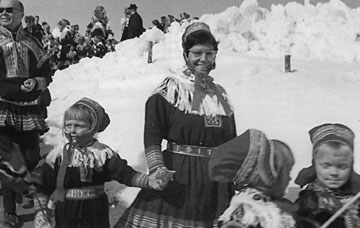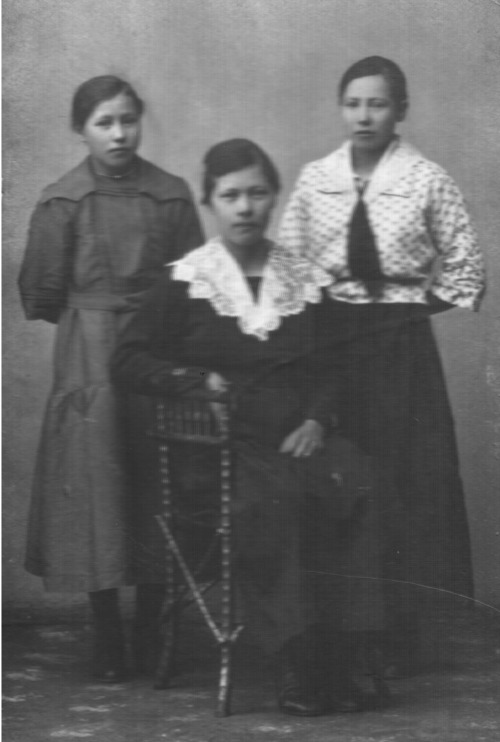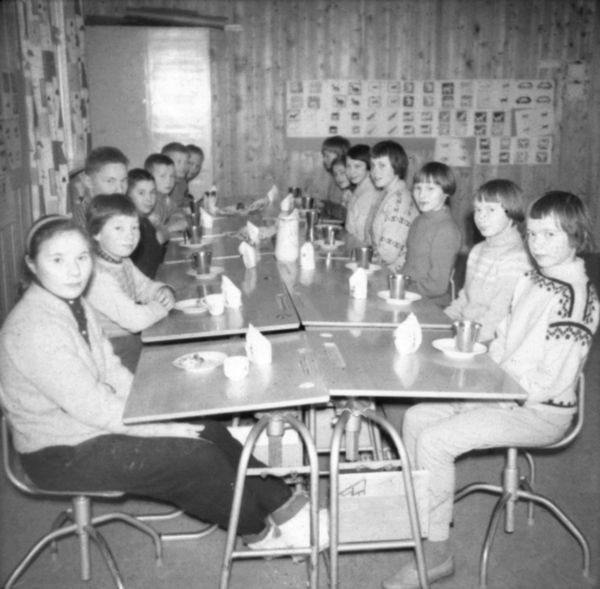 Sámegillii
Sámegillii På norsk
På norsk
New articles for Ávvir 2013
Part 30. – printed 01.06.2013
Do you know Sami school history?Here we present a series of articles printed in Sami language in the newspapers Min Áigi and Ávvir from 2007 to 2013. The basis of the articles are stories which have been collected through the project “Sami school history”. There are edited 6 books with stories and articles from school life in the Norwegian part of Sápmi. In these articles there are many quotes from the books, and we refer to the articles the quotes are taken from, to make it possible to read the entire stories there.The chief editor of Sami school history, Svein Lund, is editing this series of articles. In addition Elfrid Boine, Siri Broch Johansen and Siv Rasmussen are part of the editorial staff.
|
The instructions were primarily concerning the teaching and that children having to read and report the homeworks in Norwegian. But in the instructions from 1880 and 1898 there is a paragraph which points further. In §12 the teacher is instructed to use Norwegian also when speaking to the children outside the lessons, and in the same paragraph he is also instructed to "explain the elders, in particular the parents, whose children he is teaching, the importance to be able to speak and read Norwegian".
In the instruction there is no order for the teacher to make sure that the children do not speak Sami to each other. To the extent that this has been practiced, it mus have it's roots elsewhere than the instruction.
Let us have a look at what some of the pupils tell about whether they were allowed to speak Sami or not. Some say they were free to speak their language with each other:
– We did not experience any ban to speak Sami, we pupils spoke solely Sami together in school, the teacher was the only one we had to approach in Norwegian. But it was not always we found the words we needed.
(Kaia Kalstad, pupil in Musken in Tysfjord from 1942 – SSH2)
– In the school everything was done in Norwegian. Some pupils spoke Sami with each other, I do not remember to have heard anyone being scolded for speaking Sami.
(Edmund Johansen, pupil at Kunes in Lebesby from 1953 – SSH3)
This is also confirmed by some teachers:
– I never heard that it was forbidden to speak Sami in school, and was quite surprised when I learned that many, many years later. I've asked other Norwegian speaking teachers who have been in Kautokeino, and they all say the same.
(Inger Seierstad, teacher in Kautokeino from 1953 – SSH1)
 | Inger Seierstad celebrating the Norwegian national day togehter with her pupils in Kautokeino. She said that she never had head that children were not allowed to speak Sami (Photo: Muitalusat ja dáhpáhusat Guovdageainnus 100) |
– In school the teachers had to use solely Norwegian. But we never heard that the children were not allowed to speak Sami or Finnish.
(Bertil Johansen, teacher in Børselv school from 1965 – SSH4)
Others on the other hand say it was prohibited for the pupils to speak Sami in school:
– My Grandmother never made it a secret that she was Sami. She only spoke Sami when she in 1906 started a school where everything was done in Norwegian. It was difficult the first years when the pupils did not understand the teacher and were denied to speak together in their own language.
(Mimmi Bæivi, Hammerfest / Seiland – SSH4)
 | Three sisters at Seiland: Martha, Ella and Inga Johannessen. Martha was the grandmother of Mimmi Bæivi, who tells the story of her grandmothers school time. (Photo: Fotograf Einan, Hámmárfeasta, luoikan Mimmi Bæivi) |
– When we went to school here in Repvåg you were not allowed to speak Sami. I did not know a single word of the Norwegian language when I came to school, not a single word. Norwegian was the language in school and the foolish practice was still that we children were not allowed to speak Sami to each other, so the time would not pass in any way. When we small children were running outside and wanted to speak Sami, we were not allowed to do so.
(Ivar Utsi, pupil in Repvåg, Nordkapp from 1920 – SSH2)
– The teachers we had could speak neither Sami nor Kven. We got a clear message that at school we should only speak Norwegian. Though I am not sure who decided upon this policy.
(Ruth Rye Josefsen, pupil in Rafsbotn, Alta from 1931 – SSH1)
– We got a clear message from the teachers: It is not allowed to speak Sami. That's how the law was back then. The children did not speak Sami at all in the school, and when they came home they did not want to speak Sami there either.
(Fredrik Nilsen, pupil at Fjordtun school, Sørøysund from 1931 – SSH4)
– I started school in 1934. In school we were not allowed to speak Sami, we were not even allowed to speak Sami to the other children. Both the teachers and the home sister said so. Here we were only supposed to speak Norwegian.
(Emma Johannessen, pupil at Kårhamn school, Sørøysund from 1934, SSH4)
– We weren’t allowed to speak Sami, but what were we supposed to speak then when that was all we knew?
(Johan Johannessen, pupil in Smørfjord, Porsanger from 1938 – SSH1)
– In the classroom Norwegian was the only spoken language, and I didn't understand a word. We didn't dare to speak when we entered the classroom. We weren't allowed to speak Sami, and we didn't know Norwegian. We sat there listening, although we couldn't understand a word.
(Jon Ole Andersen, pupil in Polmak from 1939 – SSH1)
– If they spoke Sami among themselves when they were outside playing, or in the classroom, they got both a box on the ear and three strikes on the fingers with the pointer, and it hurt very much when the angry teacher hit the children on the fingers.
(Mary Laila Rasmus and Helga Sofie Sollien told to Janna Balto, Karasjok from 1939 – SSH6)
– We were taught that Sami was not a language in school, it was not allowed to speak Sami. So in our area the school was a great institution of norwegianization.
(Einar Nylund, pupil in Bjerkvik from 1944 – SSH5)
– I also remember that the teacher didn’t allow us children to speak Sámi, and that he grabbed us by the neck. And that teacher was a Sámi speaker himself.
(Ole Larsen Gaino, pupil in Kautokeino 1944 – SSH1)
Alfon Andersen from Boltås / Vatnjavárri in Skånland has told about his first year in school, 1946, in a reader's letter. Him and his twin brother Harald did not speak any Norwegian when they started school. They got strikes on the hands with the ruler if the had been speaking Sami in the breaks. Some children were pulled by the hair. Alfon says: "We small children learned fast, and because of hard strikes on small children's hands and strong hair pulling, we soon stopped speaking Sami".
(Randi Nymo, SSH1)
– Dad has told that when he went to school and the pupils spoke Sami, they were put in the corner and beaten with a ruler.
(Told by Berit Oskarsen. Karasjok. – SSH4)
– Therefore I spoke both Sami and Norwegian when I started the boarding school in Kokelv in 1962. We were three children who spoke Sami there. The others came from small places in Revsbotn. We used to speak Sami to each other, but had to do so secretly, because they denied us to speak Sami both in the school and in the dormitory.
(Bjørn Mathisen, pupil in Kokelv, Kvalsund from 1962 – SSH3)
 | From Kokelv boarding school. There children were refused to speak Sami in the 1960's. (Photo: Jáhkovuona mearrasámi musea.) |
Several tells that the prohibition was not only in force in the school, but also in the dormitory:
– The manager of the dormitory did not speak Sami, neither did the home sister. The maids spoke Sami, but they were not allowed to speak Sami with us, so we had to speak Sami secretly.
(Ivar Utsi, pupil at Lakselv school from 1950 – SSH5 )
– The employees in the dormitory, as I have later learned to know them, did all speak Sami. But the language they spoke in the dormitory was Norwegian. I do not know if they could have been ordered to use solely Norwegian, as a means to improve the Norwegian of the children in school.
(Hartvig Birkely, pupil at Billefjord boarding school from 1959 – SSH5)
14 Lappish (Sami) children have in the implied time been guided in the acquisition of the Norwegian language. The endeavours in that respect has essentially concerned the following: ...
(3) By the best possible way instruction the children to use the Norwegian language when speaking to each other also outside school hours.
(4) Through occasionally reminding the Lappish parents on the necessity of assisting the school in the norwegianizing.
(Anton Kvalsvig, 1903, Hammerfest/Sørøya – SSH4)
Johan Sirkka ... – he was teacher in Repvåg. He prohibited us to speak Sami to the children at home, and how often we were together. I remember one time in particular, when we almost got into a fight. He says: You are not allowed to speak Sami with the children! They become so stupid that they don't understand anything when they come to school!
(Ivar Utsi, father to pupils in Repvåg, Nordkapp in the 1940's and 50's, SSH2)
– What I remember best from my schooling, is when the teacher got furious because I spoke Sami in the break. It was not allowed. I even had to do detention, and the teacher walked several kilometers from the school in Elvebukt and to our house in Vigeluft on a Sunday to speak to my parents. Since that time they did not speak Sami at home anymore when I heard it.
(Johan Thomassen, pupil in Lerresfjord from 1947 – SSH6)
– Odd Finnmark – it was an experience of having arrived abroad: «Everybody speak Norwegian. No one needs to speak Finnish or Sami», was the message we were given.
I immediately became an obedient sergeant who took the Norwegian plight seriously. There is no need of neither Sami nor Finnish here!
(Anders Ole Hauglid, teacher in Lakselv from 1964 – SSH5)
In a few cases we also see that such orders have been given from the municipal school authorities:
– The children are doing their homeworks in Norwegian. ... In the breaks while playing, the children are ordered to speak Norwegian to each other, and also the teacher is solely speaking (by principle) Norwegian with the children and the parents.
(Chairman of the municipal education committee M. Vinsnes, Hasvik, 1893 – SSH3)
The question remaining unanswered is whether there at any time was given orders from the ministry or the Director of schools that the teachers should deny the pupils to speak Sami. Thus far we have not been able to find any evidence for this. Providing that someone has knowledge of this, the editorial staff of Sami school history is very interested in information.